Aibika, Edible Hibiscus
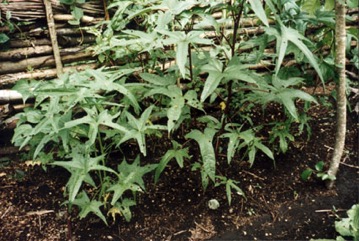
A tropical plant. It is well suited to the tropical lowlands but grows only poorly at 1800 metres. It needs fertile soil. The plant occurs in countries from India, China, Japan, Malaysia and Indonesia to the Pacific Islands. Plants will withstand occasional short-lived temperatures down to about -5°C so long as they are in a very well-drained soil. It suits areas with high humidity. It does not do well on atoll soils. It grows in humid places in Africa usually between 12°N and 12°S. It does best in well drained sandy loams. It suits hardiness zones 10-12. Hobart Botanical Gardens. In Sichuan and Yunnan.
Also known as:
Aelan kapis, Alek, Asa alek, Aso, Baera, Baero, Bamia, Ban nalu, Barakue, Bele, Dahk pool, De’e, Degi, Egarani, Ga-ana, Geba wagia, Gabe, Gedi, Glikway, Gnahi, Hapia, Huang shu kui, Huangqiu kui, Huwshiy, Jangali bhindi, Kena, Kon-kado, Kookona, Lagikway, Lata lasturi, Lema, Lope, Nambere, Nating saluyot, Neka, Ngache, Nibi, Nyahi, Olsumbe, Pangai, Paura, Pele, Po-fai, Qiu kui, Ran Bhendi, Sa are, Slimy cabbage, Slippery cabbage, Some, Soragele, Takaiya, Thakhlao maikhri gajao, Totomu, Usipak, Van lasun, Vati, Vauvau, Vauvau vati, Waci, Weko, West African Okra
Synonyms
- Abelmoschus caillei (A. Chev.) Stevels
- Abelmoschus platidactylus (Bakh.) Nakai
- Abelmoschus pseudomanihot (DC.) Endl.
- Hibiscus manihot L.
- Hibiscus manihot var. caillei A. Chev.
- Hibiscus pungens Roxb.
Edible Portion
- Leaves, Flower buds, Vegetable, Root, Fruit, Pods
Where does Aibika grow?
Found in: Africa, Andorra, Asia, Australia, Benin, Bhutan, Bougainville, Cameroon, Central Africa, Congo DR, China, Cook Islands, Côte d'Ivoire, East Africa, East Timor, Fiji, FSM, Gabon, Guinea, Guinée, Haiti, Hawaii, Himalayas, India, Indochina, Indonesia, Ivory Coast, Japan, Kiribati, Korea, Laos, Liberia, Malaysia, Micronesia, Mozambique, Myanmar, Nauru, Nepal, Niger, Nigeria, North America, Northeastern India, Pacific, Pakistan, Palau, Papua New Guinea, PNG, Philippines, Pohnpei, Rotuma, Samoa, SE Asia, Sierra Leone, Sikkim, Slovenia, Solomon Islands, Taiwan, Tanzania, Tasmania, Thailand, Timor-Leste, Togo, Tokelau, Tonga, Tuvalu, Uganda, United States, Vanuatu, Vietnam, West Africa, West Papua
Notes: There are about 15 Abelmoschus species. They are tropical and subtropical. It is high in folates.
Status: The most important edible leafy green in coastal areas of Papua New Guinea, the Pacific and SE Asia. They are an important vegetable in Africa. It is a commercially cultivated vegetable. Leaves are sold in local markets.
Growing Aibika, Edible Hibiscus
Cultivation: It is grown from cuttings. Cuttings with 2-3 nodes are sufficient. It can be grown from seeds. The narrow leafed types tend to compete less well with weeds. In some areas people tend to put the narrow leafed types in the middle of the garden, intercropped with sweet potato, and the broad leafed kinds near stumps or logs and around the edges of gardens. The pale green leafed kinds that occur only grow very slowly. Aibika is normally grown from cuttings. Lengths of about 25 cm (2 or 3 leaf joints or "nodes") of fresh green stem cuttings are used. These are simply stuck in the ground. A fertile soil is needed. Therefore Aibika can be planted in good soil in a newly cleared garden site, or it can be planted near houses where the soil fertility can be built up by adding scraps and compost and ashes. The growth and colour of Aibika leaves can be improved greatly by spraying the leaves each 2 or 3 weeks with a very small amount of the nitrogen fertiliser called urea, dissolved in water. (A 0.5% solution). This uses less fertiliser than putting it on the ground where it can wash away in the rain. Picking out the tips off branches of Aibika plants encourages the plant to produce more branches and therefore more leaves. But when you are harvesting leaves, you should not pick too many off the one bush at the one time. This is because it slows down the growth of more leaves. If the soil is very fertile, older bushes, which are only growing a few leaves, can be chopped off. The stump left in the ground can then re-grow into a new bush.
Edible Uses: Young leaves are cooked and eaten. They are slimy unless steamed or fried. They can be eaten with papaya leaves to remove the bitterness of the papaya. The root is boiled with pork to make a broth. The young fruit are cooked and eaten. They can be dried and also ground to a powder. The fruit make dishes go slimy.
Production: Leaves are ready to harvest after about 80 days. Yields of 6.7-7.3 tons/ha/crop have been recorded. It flowers in 50-110 days. This gets longer with increasing daylength. Plants can take 4 to 12 months until fruit are ready. Production can continue to an extended time.
Nutrition Info
per 100g edible portion| Edible Part | Energy (kcal) | Protein (g) | Iron (mg) | Vitamin A (ug) | Vitamin c (mg) | Zinc (mg) | % Water |
|---|---|---|---|---|---|---|---|
| Leaves | 29 | 3.4 | 1.5 | 1 | 7 | 1.2 | 88 |
| Flower buds | - | - | - | - | - | - |
Aibika, Edible Hibiscus Photos

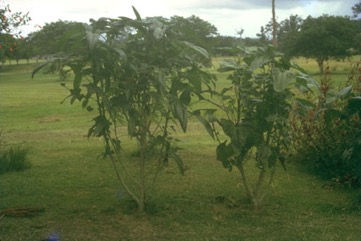
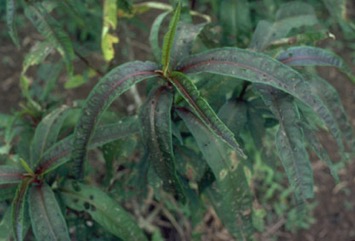
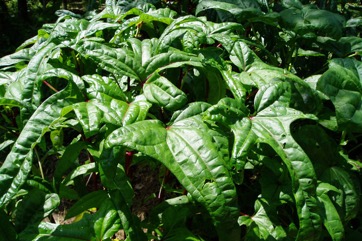
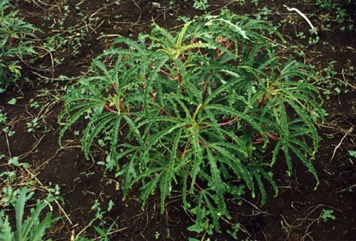
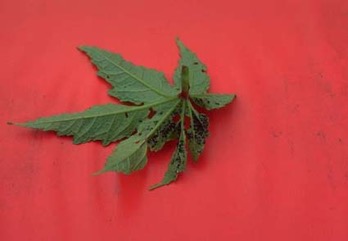
References
Aibika references Abelmoschus manihot Syn Hibiscus manihot.
Altschul, S.V.R., 1973, Drugs and Foods from Little-known Plants. Notes in Harvard University Herbaria. Harvard Univ. Press. Massachusetts. no. 2763
Ambasta S.P. (Ed.), 2000, The Useful Plants of India. CSIR India. p 1
Army Veterinary Medicine Edible Wild Plants, 1944.
Backer, 1911, Schoolflora voor Java p 126
Backer, and Bakhuizen, 1963, Flora Java Vol. 1 p 434.
Barrau, J., 1958, Subsistence Agriculture in Melanesia. Bishop Museum Bulletin 219 p 56 (As Hibiscus manihot)
Barrau, J., 1976, Subsistence Agriculture in Polynesia and Micronesia. Bernice P. Bishop Museu, Bulletin 223 Honolulu Hawaii. Kraus reprint. p 58
Bates, D.M., Notes on the cultivated Malvaceae 2. Abelmoschus Baileya 16:99-122
Borssum-Waalkes, van J., 1966, Malesian Malvaceae revised. Blumea 14(1) p23
Bull. Mus. Natl. Hist. Nat., B, Adansonia 10:138. 1988 (As Abelmoschus callei)
Burkill, H. M., 1985, The useful plants of west tropical Africa, Vol. 4. Kew. (As Abelmoschus callei)
Burkill, I.H., A Dictionary of the Economic Products of the Malay Peninsula p
Cavanilles, 1787, Diss. 3:172, t 168 fl H. palmatus
Cherikoff V. & Isaacs, J., The Bush Food Handbook. How to gather, grow, process and cook Australian Wild Foods. Ti Tree Press, Australia p 198
Clarke, W.C. & Thaman, R.R., 1993, Agroforestry in the Pacific Islands: Systems for sustainability. United Nations University Press. New York. p 236 (As Hibiscus manihot)
Cowie, I, 2006, A Survey of Flora and vegetation of the proposed Jaco-Tutuala-Lore National Park. Timor-Lests (East Timor) www.territorystories.nt/gov.au p 50
Cundall, P., (ed.), 2004, Gardening Australia: flora: the gardener's bible. ABC Books. p 67
De Clerq, 1909, Niew Plantk Woordenb p 254 no 1794
De Clerq, 1927, Niew Plantk Woordenb. 2 nd ed p 79 no 1844.
Dobriyal, M. J. R. & Dobriyal, R., 2014, Non Wood Forest Produce an Option for Ethnic Food and Nutritional Security in India. Int. J. of Usuf. Mngt. 15(1):17-37
ecocrop.fao.org
Elliot, W.R., & Jones, D.L., 1982, Encyclopedia of Australian Plants suitable for cultivation. Vol 2. Lothian. p 4
Facciola, S., 1998, Cornucopia 2: a Source Book of Edible Plants. Kampong Publications, p 146
Filet, 1888, Plantk Woordenb. 2nd ed p 78 no 1844
Franklin, J., Keppel, G., & Whistler, W., 2008, The vegetation and flora of Lakeba, Nayau and Aiwa Islands, Central Lau Group, Fiji. Micronesica 40(1/2): 169–225, 2008
French, B and Bridle, C., 1978, Food Crops of Papua New Guinea p 32, 33.
French, B.R., 1982, Growing Food in the Southern Highlands Province, PNG. SHRDP, Mendi PNG
French. B.R., 1986, Food Plants of PNG A compendium. PNG Biological Foundation. p 56.
French, B.R., 2010, Food Plants of Solomon Islands. A Compendium. Food Plants International Inc. p 151
Furusawa, T., et al, 2014, Interaction between forest biodiversity and people's used of forest resources in Roviana, Solomon Islands: implications for biocultural conservation under socioeconomic changes. Journal of Ethnobiology and Ethnomedicine, 10:10
Gamble, G., 1935 Flora of Madras Vol 1 p 69
Grubben, G. J. H. and Denton, O. A. (eds), 2004, Plant Resources of Tropical Africa 2. Vegetables. PROTA, Wageningen, Netherlands. p 21 (As Abelmoschus callei)
Hale, P.R., and Williams, B.D., 1977, Aibika in Liklik Buk p 19 Melanesian Council of Churches.
Hamilton, L., 1955, Indigenous versus Introduced Vegetables in the Village Dietary. PNG Ag. J. , Oct. 1955.
Hamon, S. et al 1987, Collecting Abelmoschus germplasm in Thailand IBPGR SE Asian Newsletter April ‘ 87 p 3-5
Hamon, S., and Yapo, A., 1986, Pertubations induced within the genus Abelmoschus by the discovery of a second edible okra species in West Africa. Acta Horticulturae 182 p 133.
Heyne, 1927, Nutt. Plant. p1037
Hochreutiner, 1900, Ann. Cons. Jard. Bot. Geneve 4:153
Hochreutiner, 1924, Candollea 87
Hu, Shiu-ying, 2005, Food Plants of China. The Chinese University Press. p 538
IBPGR , 1987, Ecogeographic survey of wild Abelmoschus IBPGR Rome
IBPGR report 133, Solomons 1986, in Pl. Genetics res Newsletter 69 p 51
Joshi, N., et al, 2007, Traditional neglected vegetables of Nepal: Their sustainable utilization for meeting human needs. Tropentag 2007. Conference on International Agricultural Research for Development.
Kays, S. J., and Dias, J. C. S., 1995, Common Names of Commercially Cultivated Vegetables of the World in 15 languages. Economic Botany, Vol. 49, No. 2, pp. 115-152
Kesavan, V., 1980, Aibika (Hibiscus manihot (L.)) in PNG in IBPGR SE Asian Newsletter 4(1):9
Kesavan, V., List of Descriptors for Aibika. In IBPGR Newsletter p 8,9
Kiple, K.F. & Ornelas, K.C., (eds), 2000, The Cambridge World History of Food. CUP p 1861
Kuvar, S. D. & Shinde, R. D., 2019, Wild Edible Plants used by Kokni Tribe of Nasik District, Maharashtra. Journal of Global Biosciences. Volume 8, Number 2, 2019, pp. 5936-5945
Kuwada, H., 1957, Cross compatibility in the reciprocal crosses between amphiploid and its parents (Abelmoschus esculentus and A.manihot ) and the characters and meiotic division in their hybrids obtained among them. Jap. J. Breed., 7, 103-111.
Latham, P. & Mbuta, A. K., 2017, Plants of Kongo Central Province, Democratic Republic of Congo. 3rd ed p 9
Lim, T. K., 2015, Edible Medicinal and Non Medicinal Plants. Volume 9, Modified Stems, Roots, Bulbs. Springer p 2
Linne, 1753, Hibisucs manihot L. Sp Pl 696
Maghirang, R. G., et al, 2018. Ethnobotanical Studies of Some Plants Commonly Used as Vegetables in Selected Provinces of the Philippines. Journal of Nature Studies. 17(2), 30-43.
Makino, 1962, Makino’s New Illustrated Flora of Japan. Hokuryukan Co. Tokyo p 389
Manandhar, N.P., 2002, Plants and People of Nepal. Timber Press. Portland, Oregon. p 63
Martin, F.W. & Ruberte, R.M., 1979, Edible Leaves of the Tropics. Antillian College Press, Mayaguez, Puerto Rico. p 45
Martin, F.W. and Rhodes, A.M., 1983, Seed characteristics of okra and related Abelmoschus species. Qualitas Plantarum Plant Foods for Human Nutrition 33(1):41-49
Massal, E. and Barrau, J., 1973, Food Plants of the South Sea Islands. SPC Technical Paper No 94. Noumea, New Caledonia. p 35
Medhi, P. & Borthakur, S. K., 2012, Phytoresources from North Cachur Hills of Assam -3: Edible plants sold at Hflong market. Indian Journal or Natural Products and Resources. 3(1) pp 84-109
Medic, 1787, Abelmoschus manihot (L.)Medic. Kunstl. Geschl. Malvenfam. - Fam 46
Mendoza, 1959, Philippines J. Sci. 88:260
Milliken, W., 2,000, Ethnobotany of the Yali of West Papua. Royal Botanic Garden, Edinburgh (near Baliem)
Monsalud, M.R., Tongacan, A.L., Lopez, F.R., & Lagrimas, M.Q., 1966, Edible Wild Plants in Philippine Forests. Philippine Journal of Science. p 492 (As Abelmoschus manihot subsp. manihot fo. speculatus)
Nerkar, Y.S., and Jambhale, N.D., 1985, Transfer of Resistance to yellow vein mosaic from related species into okra (Abelmoschus esculentus (L.)Moench. Indian J. Genet. 45(2):261-270.
Ochse, J.J. et al, 1931, Vegetables of the Dutch East Indies. Asher reprint. p 464
Oomen, H.A.P.C., & Grubben, G.J.H., 1978, Tropical Leaf Vegetables in Human Nutrition, Communication 69, Department of Agricultural research, RTI Amsterdam, p 97
Peekel, P.G., 1984, (Translation E.E.Henty), Flora of the Bismarck Archipelago for Naturalists, Division of Botany, Lae, PNG. p 365, 366
Pham-Hoang Ho, 1999, An Illustrated Flora of Vietnam. Nha Xuat Ban Tre. p 530
Powell, J.M., 1976, Ethnobotany in Paijmans, K., (ed.), New Guinea Vegetation. Elsevier. p124.
Plants for a Future database, The Field, Penpol, Lostwithiel, Cornwall, PL22 0NG, UK. http://www.scs.leeds.ac.uk/pfaf/
Prafulla, S., 2017, Wild Food Diversity of Nawegaon-Nagzira Tiger Reserve in Gondia-Bhandara district of Maharashtra, India. Int. J. of Life Sciences, 2017, Vol. 5 (4): 620-626
Prakash, V., & Megrotra B.N., 1987, Ethnobotanical Studies on the Flora of Khandala, Maharashtra State. J. Econ. Tax. Bot. Vol. 9 No. 1 pp 205-208
(PROSEA) Plant Resources of South East Asia 8:58. 1993 (As Abelmoschus callei)
Plant Resources of Tropical Africa Protabase record. http://database.prota.org (As Abelmoschus callei)
Shimizu, N.; Tomoda, M., 1985, Carbon 13 nuclear magnetic resonance spectra of alditol-form oligosaccharides having the fundamental structural units of the Malvaceae plant mucilages and a related polysaccharide. Chemical and Pharmaceutical Bulletin 33(2): 5539-5542.
Siemonsma, J. S. and Piluek, K. (Eds), 1994, Plant Resources of South-East Asia No. 8 Vegetables. Prosea Foundation, Bogor, Indonesia, p 60
Sims, 1815, in Curtis, Bot Mag. 42 t 1702
Sillitoe, P. 1995, An Ethnobotanical Account of the Plant Resources of the Wola Region, Southern Highlands Province, Papua New Guinea. J. Ethnobiol. 15(2): 201-235 (As Hibiscus)
Staples, G.W. and Herbst, D.R., 2005, A tropical Garden Flora. Bishop Museum Press, Honolulu, Hawaii. p 384
Sujatha, V.S., Madaan, T.R. and Seshadri, V.S. 1986, Oil content and its quality in seeds of wild and cultivated species of Abelmoschus. Indian J of Sci. (India) v 56(9) p657-660.
Tanaka, T., 1976, Tanaka’s Cyclopedia of Edible Plants of the World p1
Tang ya, Malvaceae. Flora of China. p
Terra, G.J.A., 1966, Tropical Vegetables. Communication 54 e Royal tropical Institute, Amsterdam. p 52
Thaman, R.R., 1976, The Tongan Agricultural System, University of the South Pacific, Suva, Fiji. p 403
Thaman, R. R., 1987, Plants of Kiribati: A listing and analysis of vernacular names. Atoll Research Bulletin No. 296
Thaman, R. R., et al, 1994, The Flora of Nauru. Atoll Research Bulletin No. 392. Smithsonian Institute p 39
Thaman, R. R, 2016, The flora of Tuvalu. Atoll Research Bulletin No. 611. Smithsonian Institute p 97
Tindall, H.D., 1983, Vegetables in the Tropics, Macmillan p 328
Umerura, J., 1906, Flora of Edible Plants.
USDA, ARS, National Genetic Resources Program. Germplasm Resources Information Network - (GRIN). [Online Database] National Germplasm Resources Laboratory, Beltsville, Maryland. Available: www.ars-grin.gov/cgi-bin/npgs/html/econ.pl (10 April 2000) (Also as Abelmoschus callei)
Walters, C.L. (ed), 1961-62. Survey of Indigenous Agriculture and Ancillary Surveys. Bureau of Statistics. Papua.
Walter, A. & Lebot, V., 2007, Gardens of Oceania. ACIAR Monograph No. 122. p 111
Weinberger, K., Msuya J., 2004, Indigenous Vegetables in Tanzania. Significance and Prospects. Technical Bulletin No. 31 AVRDC, Taiwan/FAO p 4 (As Abelmoschus callei)
Westwood, V., and Kesavan, V., 1981, Traditional Leafy vegetables of PNG: aibika (Hibiscus manihot (L.)) in Bourke, M., (ed), Proc. PNG Food Crops Conf.
Whistler, W. A., 1988, Ethnobotany of Tokelau: The Plants, Their Tokelau Names, and Their Uses. Economic Botany 42(2): 155-176
Wiggins, I.L., and Porter, M.M., 1971, Abelmoschus manihot (L.) Medic in Flora of the Galapagos. p 668.
Woodward, P., 2000, Asian Herbs and Vegetables. Hyland House. p 9
Wahyudi, 2017, Non-timber Forest Product (NTFP) Commodities Harvested and Marketed by Local People at the Local Markets in Manokwari - West Papua. Indonesian Journal of Forestry Research Vol. 4, No. 1, 27-35
Wiriadinata, H., 1995, Ethnobotany of Economic Plants in the Baliem Valley, Jayawijaya, Irian Jaya, Indonesian Institute of Science, Bogor, Indonesia (As Hibiscus)
World Checklist of Useful Plant Species 2020. Royal Botanic Gardens, Kew
Xu, Z., Tao, G. & Tan, J., 1988, Tropical Wild Flowers and Plants in Xishuangbanna, Agricultural Publishing House. photo 97
Yuncker, T.G., 1959, Plants of Tonga, Bernice P. Bishop Museum, Hawaii, Bulletin 220. p 185